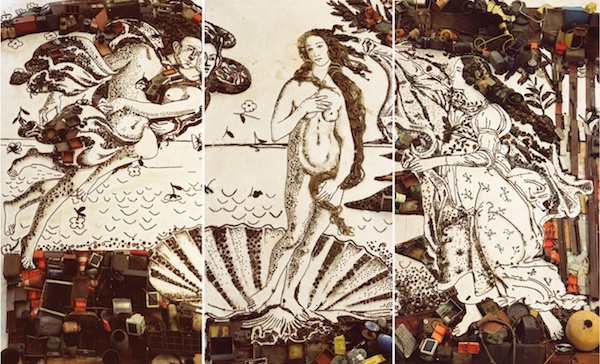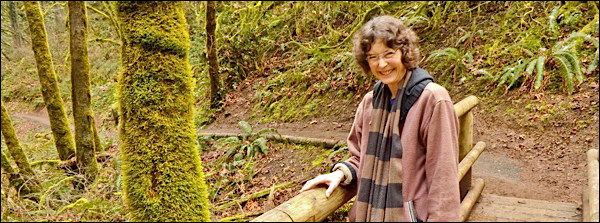Unearthing
“Are there ‘something elses’ that stop changing, thus becoming immortal in some sense, but at the same time dangerous because they take no further part in the life/death cycle that rounds out our days? A person could approach good and evil this way if a person weren’t afraid of falling.”—Anita Sullivan
On The Other Hand
By Anita Sullivan

EUGENE Oregon—(Weekly Hubris)—November 2016—What lies on top of the ground, and for what reason? These two questions have occupied me for the past several months, since I moved into a neighborhood between the Willamette River and the railroad yard, three blocks from a tent-camp for some of the city’s homeless folks, and upwind from a row of chemical and paper factories belching environmentally-corrected poisons into the air.
It’s a kind of industrial zone on the alluvial plain of a mighty river. In this unfashionable part of town, large portions of ground have come to function as little more than a handy flat surface, an enormous junk yard on which, over many years, many things have been dropped which in other places might have been more carefully isolated into discretely sorted piles, destined for further use. Much of this stuff, scattered in small bits and pieces, rests on the many dirt, grass, or gravel surfaces largely invisible, as if it were assumed to be part of the topsoil.
Our dear Earth is used to humans and their trashy ways. She swallows endless cast-off materials and, like a junk dealer, doesn’t immediately discriminate between stuff that’s useful and stuff that’s not.
But, eventually, Earth, like the enormous Cow of ancient Indian mythology, begins to chew her cud—and, being a true Lady, she spits out the things she cannot digest.
Yes, there are some things our compliant Earth—our trash-bin of last resort—can’t deal with. Like cigarette butts. Like old nails. Like many, many species of plastic. She takes them down a few feet, tries to absorb them into her vast bacterial/chemical soup but, failing that, eventually belches them back up to the surface again, almost intact. These “useless immortals” loiter on the ground for years as a kind of topsoil, until eventually they may be raked up and sifted out by an unusually meticulous gardener, or (more likely) paved over for awhile, and thus sent temporarily back underground until dear Earth once again gently refuses any more to house them.
Certain words occur: spew, vomit, disgorge. In the words of German forester Peter Wohlleben, “Whereas it is generally accepted that we know less about the ocean floor than we know about the surface of the moon, we know even less about life in the soil.” Soil doesn’t include everything that goes down under.
It’s clear that earth has her limits in what we can fob off on her, and what her amazing underground cauldron can restructure into nourishment.
I admit to a kind of puzzled amazement. In my own front yard I have stumbled onto another example of an ancient vexing question: At what point does a thing change enough to become something else instead? And are there “something elses” that stop changing, thus becoming immortal in some sense, but at the same time dangerous because they take no further part in the life/death cycle that rounds out our days? A person could approach good and evil this way if a person weren’t afraid of falling.
A decade ago, I spent two weeks in the Peloponnese as a volunteer on a sort of archaeology mop-up operation. Our task was to walk slowly through acres of olive groves and grape arbors, with the owners’ permission, and scan the ground for pottery shards. This is an archaeology research tactic based on the assumption that a high concentration of pottery fragments on the surface signals a good chance of there being a significant archaeological site directly under it.
We were supposed to fail. The hope and expectation (ardently shared, I am sure, by the local olive and grape farmers) was that this area lay in an uninhabited zone between the Mycenaean Palace of Nestor (already excavated and open to tourists), and a smaller district capital site called Iklaina. So, the fact that every day each of us skimmed off and briefly examined hundreds of pottery fragments spanning a period from the Middle Bronze Age to the present, this only meant that we were in Greece, where the topsoils and sub-soils are routinely clogged with several thousand years of human artifacts. You can feel it when you walk, the layers and layers of rich history literally holding you up. It can make your feet feel positively springy!
In this case, Earth had not identified these bits of old pots as indigestible. Their appearance on the surface was an indication of chronic overload and temporary storage, not of outright rejection. For Earth, “eventually” is simply the slowest, the most sotto voce of all her splendid rhythms.
My yard, however, is at the opposite end of this spectrum of useful things morphing into other useful things. In my future garden space the shards I find on the surface are, indeed, trash. Who bothers to pick them up and throw them away is a fool. I am a fool. Not only is the supply endless, but also constantly renewing itself.
Yes, this is the final, the almost diabolical part: I can pick up a broken bottleneck, endless squares of rusty metal, half a dozen cigarette butts, a brass screw, seven shreds of plastic tarp, a scrap of polyester, a small key ring, all of this from a small and very familiar section of ground I have already raked and dug and mulched for next spring’s planting, and the next day I will find pretty much the same shabby little group of items lying in the same area.
These replacements have not been sent to the surface for temporary storage; these are new rejects from what surely must be a finite supply. Unlike the rocks—large and small, that Earth keeps slowly bringing up to the surface to make room “down there” for the new ones being formed in the deep core—unlike these, the thousandfold bits of indestructible matter we have made by a kind of skewed alchemy into permanent trash status, swirl around our feet like an icy breeze. There is no eject button for them; they have come to their final point of no return. I put on my thick socks, my paint-stained jeans, my gloves, and I bend again to my task.
Inside the local landfill, perhaps these things will slowly be crushed and blended into something destructible again, so that they can rejoin the normal world.
![]()
Note: The image illustrating this essay derives from: https://www.pinterest.com/pin/213991419765797184/
![]()
To order Anita Sullivan’s book, Ikaria: A Love Odyssey on a Greek Island, click on the book cover below.



3 Comments
Will B
Ah! Both soil and its detritus – in the same essay! Treasures, both, if one lives in the right spot. A delight, Anita.
Elizabeth Boleman-Herring
Dearest Anita, how lovely to read this, in our magazine, the day after the election, and find you–as it were–puttering in your, our, garden. Life goes on. Bless you and keep you…. Your Loving Editor
Anita Sullivan
Thank you both, dear ones!